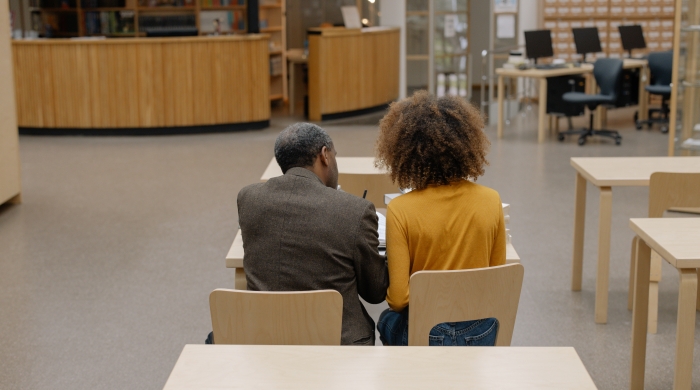Excellence for All (EFA) is a Boston Public School (BPS) district initiative to address the need for equitable access and opportunity for student learning (EFA, 2019). EFA is positioned within the Office of Opportunity Gaps, whose mission is to “build capacity and provide the vision, innovation, and supports the district and its individual schools need to foster opportunities for marginalized students, (Black, Latinx, emergent bilinguals, students with disabilities, and low socioeconomic status students) to flourish and close gaps in proficiency across all areas of their education,” (EFA, 2019). EFA was formed in 2016 as a direct response to the needs of underserved and historically marginalized students. As of fall 2019, EFA is operating in 15 schools across the district.
EFA outlines five pillars that guide the design and implementation of program. These include (1) rigorous instruction, (2) quality enrichments, (3) culturally and linguistically sustaining practices/ social emotional learning, (4) executive function, and (5) personalized learning.
Rigorous instruction ensures that students are exposed to high quality education that includes support and coaching to best prepare educators for leading 21st Century classrooms. EFA instruction is designed to challenge students’ academic and social emotional growth, particularly around writing, organization, and critical thinking.
Quality enrichment focuses on increasing student access to STEM and world language. Through these offerings, students may experience coding, robotics, engineering, as well as language classes (e.g. Spanish, French, and Mandarin). These courses are designed to challenge students to think critically about math and science. Specifically, for students of color, the enrichments allow students to envision themselves in fields in which they are typically under-represented.
Culturally and linguistically sustaining practices (CLSP) and social emotional learning (SEL) remind EFA participants to honor each other’s humanity. CLSP and SEL center students’ identities and lived experiences, which greatly impact their learning within and outside of the classroom. This EFA pillar focuses on ensuring classrooms are safe and welcoming spaces where students feel encouraged to learn. Through this practice, academic instruction is rigorous and affirms students’ cultural identities.
Executive function is support for both students and teachers to organize, plan, and manage. This support encourages students to be self-regulated learners, deepen their critical thinking, and focus on their academic and social emotional growth. EFA highlights executive function as a key pillar of its program, as it helps students gain needed skills to complete both simple and complex tasks. This pillar includes coaching and supporting individual student and school needs through complex tasks like the capstone project.
Personalized learning fosters opportunities for teachers to stimulate students’ academic and social emotional growth through student-led learning. The crux of this pillar is the capstone, where all 4-5th grade EFA students are expected to complete a research project on an area of interest. Through this project, EFA boasts students are supported in their own “unique pathway to success.”
Schools implementing EFA with fidelity have programming, practices, and policies related to each of these five pillars. However, the EFA model allows schools some flexibility in choosing the specific components that best fit their school context. The only required EFA components across all schools include:
- Capstone: an interdisciplinary project completed by 4th and 5th grade EFA student classrooms and presented at a public forum during the spring term. Students are challenged to do deep-analysis on a chosen project and use their self-reflections as data to present.
- The Partnership in Education and Resilience (PEAR) Institute’s Holistic Student Assessment (HSA): a data-driven tool to promote social-emotional development in young people in school and after school settings. This assessment is administered at the beginning and end of each school year to students in 4th and 5th grades, with parental consent. It contains a self-report tool, which provides teachers, staff, and administrators with a social-emotional “portrait” of the unique strengths and challenges of each student.
- Senior Coaches: an individual assigned to each EFA school to support program implementation. Senior coaches check-in with principals, support strategic planning (around the use of EFA resources), and support teachers’ capstone planning and execution.
Other EFA activities offered, but not required, are (1) Systemic Functional Linguistics (SFL) Writing, (2) STEM, (3) World language, (4) reading intervention, and (5) EdVestors Math.
EFA serves a wide range of students across Boston. As of Spring 2019, EFA programs operate in nine Boston neighborhoods: Allston, Brighton, Charlestown, Dorchester, East Boston, Hyde Park, Jamaica Plain, Roslindale, and Roxbury. Students in EFA classrooms closely reflect district-wide demographics. Compared to district data for the 2017-2018 school year, EFA classrooms were mostly composed of Latinx and Black students, 47% and 32% respectively. White students made up 11% of the students, and Asian students 6%. Emergent bilinguals and students with disabilities (SWDs) were also represented in EFA classrooms at 38% and 22% respectively, which were both rates higher than district-wide averages.
Purpose of EFA Evaluation
NYU Metro Center was contracted by BPS to document the EFA implementation across BPS schools and the quality of support offered around student learning. To guide this evaluation, we posed the following questions:
- How has EFA contributed to the academic and social emotional development of students, including cultivating confidence and academic perseverance?
- How has EFA provided support and coaching for teachers and school staff?
- In what ways are students and families satisfied with EFA?
Boston Public Schools District Background and History of Racial Inequity
BPS is one of the nation’s most diverse school districts. More than 50,000 students are enrolled in their PK-12th grade programs. Largely comprised of students of color, 42% identify as Latinx, 34% as Black/ African American, 9% as Asian, 3% as multi-racial, and less than 1% as Native American and Native Hawaiian/ Pacific Islander. 76% of students are described as high needs (i.e. students who identify as SWDs, current or former emergent bilinguals, and/or economically disadvantaged).
Although White students only make up 14% of the district, they are more likely to be enrolled in schools offering rigorous learning opportunities, including placement in AWC classrooms; completion of Independent School Entrance Exam (ISEE) prep, which prepares students to take an exam to gain entrance into BPS exam schools; as well as completion of the MassCore curriculum (e.g. rigorous curriculum standards that align high school course work with college and workforce standards (BPS, 2019; Tung et.al, 2015; Miranda et.al, 2014). This section discusses historical moments that led to educational opportunity and reform in Boston, as well as outline the theoretical frameworks guiding our data analysis.
Inequities in Boston’s public-school system date back to its inception. As one of the first colonial states to enforce legislation determining education a public responsibility, there is a strong educational history. Early grammar schools were established in Boston for children to
learn how to read, write, and do arithmetic (DOE Mass, 1930). Families were responsible for ensuring their children were educated, as well as required to provide some form of financial compensation for the school teacher (DOE Mass, 1930). This opportunity, however, was not always as accessible for students of color and students from low-income families.
Historically marginalized students in Boston have a long history of racial segregation, economic disadvantage, and denied opportunity (Fraser, Allen, and Barnes, 1979; Wolff and Rights, 2014). Legislation dating back to the 19th Century documents Black families’ struggle to achieve educational equity (1849 Roberts v. City of Boston; Wolff and Rights, 2014). While de-facto segregation (i.e. school segregation resulting from discriminatory housing policies) was widely recognized by Black families, it was not acknowledged publicly as a barrier to educational opportunity by Massachusetts state and local Boston government until the mid-1960s (Fraser, Allen, and Barnes, 1979; Wolff and Rights, 2014). After many years of inaction, the district was mandated to desegregate its schools through court-ordered busing (Hornburger,
1976; Wolff and Rights, 2014).
From 1974 to 1988, nearly 20,000 students a year were bused throughout the city of Boston to address the racial imbalance fueling district-wide inequities (Fraser, Allen, and Barnes, 1979; Hornburger, 1976). The order for city-wide integration fueled not only anger, but targeted violence toward minority families, resulting in the deployment of the National Guard to enforce desegregation and provide protection for minority students (Hornburger, 1976).
Over the last 30 years, there have been various reform efforts within the city of Boston to create more equitable schooling choices (McEnroe, 2014). Student assessment standards were established via the Mass Education Reform Act of 1993, including the statewide standardized test (Massachusetts Comprehensive Assessment System or MCAS), teacher professional development and licensure requirements, school performance indicators, and the creation of autonomous schools (McEnroe, 2014). Even still, tracking within individual schools and restrictions on accessibility to academic enrichment programs has continued to perpetuate educational inequities in BPS (Weiner, 2016).
The Achievement Gap Act of 2010 established school-level assessment and accountability standards, which led to the development of “Turnaround Schools” (i.e. level 4 and 5 schools in the district demonstrating they are underperforming or chronically underperforming).(Pauley and Martin, 2011). A 2011 report on education reform in Massachusetts following the implementation of the Achievement Gap Act highlighted students in attendance at Turnaround Schools were mostly emergent bilingual students, SWDs, low-income students, and Latinx or Black/African American (Pauley and Martin, 2011). Eight years later, BPS school-level data still demonstrates these students are underserved in the district and are most likely to be enrolled in level 3 or higher schools.
In their 2014 report “Opportunity and Equity,” the Annenberg Institute for School Reform (AISR) and the Center for Collaborative Education (CCE) recommended that BPS “convert all grade 4-6 classrooms into AWC classrooms, with high expectations and rigorous coursework.” In this same year, BPS began to observe student performance, school climate, and cultural norms to examine more closely racial inequities in the district. With the 2015-2016 school year came a new superintendent, who committed to a 100-day tour to determine how to expand district opportunities for historically marginalized students. An evaluation of student, teacher, and community member perceptions of district opportunities led to a proposal for the development of EFA. The EFA initiative was created in response to this recommendation, which was backed by many district officials, educators, and community organizers.
In 2016, the Office of Opportunity Gaps at Boston Public Schools developed a Culturally and Linguistically Sustaining Practices Continuum, which provided additional grounding for the EFA initiative. In this continuum, BPS defined culturally responsive and linguistically sustaining practices as “draw[ing] upon, infus[ing] and evok[ing] students’ existing schema, experiences, funds of knowledge, and perspectives to optimally facilitate learning,” (Rose and Fredrick-Clark, 2016, p.1). Through the development of their equity-based CLSP Continuum, BPS began to have more public conversations and create actionable steps to address barriers to educational opportunities. Authors Rose and Fredrick-Clark (2016) understood cultural competency as a range. Stage 1 is described as pre-competence or “becoming aware of one’s lens and bias.” Stage two is cultural learning and relationship building through learning in partnership, including understanding each students’ background and how their identity influences learning. Lastly, stage 3 was understood as cultural proficiency, or “utilize[ing] the cultural knowledge of students, families, and communities to adapt practices, materials and environments to engage, motivate, and facilitate deep learning,” (Rose and Fredrick-Clark, 2016, p.1).
EFA implementation began in SY 2016- 2017 with 13 schools. A project manager, now employed as the program director, was the only program staff, and was hired to oversee the day to day operations of the initiative. This position was created after primary decisions about the EFA program were made, including program goals, areas of focus, and middle schools that would function as pilot year schools. During SY 2017-2018, additional program staff were hired to assist the program director, including senior coaches, a program manager, and a program assistant. In SY 2018-2019, an additional three schools were added to the EFA roster as well as more coaching staff. These stand-alone pathway middle schools were specifically chosen in an effort to preserve the district’s promise to serve 4-6th grade students, as many of the initial EFA schools were K-5.
Currently, there are 84 schools in BPS serving 4-6th grade students. As of fall 2019, EFA currently only operates in 15 schools. This leaves a disproportionate number of students who are not receiving the vast academic and social emotional enrichments offered through the EFA model. Additionally, 11 BPS schools serving 4-6th grade students still offer AWC or AWC-hybrid classrooms (i.e. classrooms where general education students learn alongside students who have tested into the AWC program), even as research documents AWC’s divisiveness (Tung et.al, 2015; Miranda, et. al., 2014).
An analysis of the historical underpinnings in BPS is critical to our understanding of current reform efforts in the district. The pursuit for access to classroom resources, quality materials, qualified educators, and overall supportive learning environments has been a long fight for historically marginalized communities. Despite many efforts to create equitable schooling opportunities, many Boston schools are still very heavily segregated by race, SES, English language proficiency, and IEP/ SWDs status.










